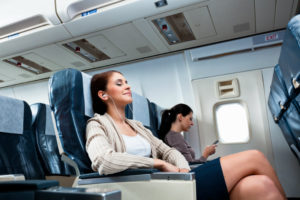Learn to manage travel anxiety for an enjoyable flight with these tips from Captain Lim Khoy Hing.

Image: Travel 3Sixty
Without a doubt, sound knowledge and understanding of the principles of flying go a long way in helping one relax enough to enjoy a flight; this is something I have frequently reiterated in my earlier articles. However, despite being well informed on the safety of air travel, anxiety continues to plague nervous travellers, sometimes, even hindering their travel dreams.
Psychologists have attributed aerophobia to three main triggers: the anxiety caused by the unknown, and a lack of faith in the machine and crew. Conversely, statistics clearly prove that when compared to other modes of transportation, flying is still one of the safest forms of travel.
‘DRIVERS’ IN THE SKY
Unlike motorists, pilots receive intensive and rigorous training. For instance, even after pilots become qualified, every six months they are re-examined on various technical aspects using flight simulators, in order to refresh their training on safety measures.
To obtain a driver’s license, all you need to do is pass a driving test once, and you are assumed a competent driver for life. However, for ‘drivers’ in the sky, the skill to fly is continuously honed throughout a pilot’s career – no wonder an airline pilot is rated as having the third most stressful job in the world!
TURBULENCE & STRESS
One of the triggers of flight anxiety is the uneasiness caused by air turbulence. In actual fact, turbulence is not a safety matter; as long as passengers adhere to inflight safety instructions and remain securely strapped in with their seat belts on, turbulence is only a matter of discomfort.
Although turbulence is not at all a concern, some passengers are still anxious about it. This is a result of how our brain works. The organ responsible for this unpleasant feeling is the amygdala, the part of the brain that releases stress hormones. As an example, if you were to lose balance atop a step ladder, your amygdala would fire off stress hormones, forcing you to take notice that you are falling towards the ground.
A small shot of adrenaline is enough to get your attention, but, generally, does not cause undue distress. However, turbulence may release a lot more adrenaline, causing increased breathing and tension based on a primal fight or flight response.
THE 5-4-3-2-1 EXERCISE
Captain Tom Bunn, a former United Airlines captain and flying anxiety guru, as well as a licensed therapist, introduced a way to overcome this unpleasantness with a simple 5-4-3-2-1 exercise.
Begin by ensuring that you are in a comfortable seated position.
Focusing on an object in front of you, say the words ‘I see’, and name something in your peripheral vision. Continue until you have made five statements.
Maintaining your focus, say the words ‘I hear’, and name something you hear onboard the plane. Continue until you have made five statements. Next, say the words ‘I feel’, and name five things you feel. That completes one cycle. This takes intense concentration, which is precisely the purpose of this exercise. As you concentrate on things that are not intimidating, the ‘fight or flight’ hormones present in your body gradually subside, and as a result, you relax.
Captain Bunn suggests that to keep concentration intense, the flyer should continue to make five statements, then, four. In the next cycle, go for three statements, followed by two, and finally, one. This cycle can be repeated starting with five statements and moving back to one.
This exercise should be employed as early as possible when on board the plane to control anxiety when flying. Remember that this is a concentration exercise to keep your mind diverted. It basically makes you use your senses of sight, hearing and perception to keep your mind occupied.
So, whenever you feel the onset of flight anxiety, immediately distract yourself by doing the 5-4-3-2-1 exercise every five minutes, gradually increasing the period between exercises to 15 minutes, and then every hour. Stop when you find yourself becoming relaxed. Forgetting which cycle you’re in while doing the 5-4-3-2-1 is great because this means that you are becoming relaxed… so relaxed, in fact, that you completely lose count!
GET ON BOARD
To start your journey to calmness well before you fly, I recommend ensuring that you’re prepared with everything you need for your trip (bring along your favourite books or download your favourite tunes for in-flight enjoyment), and arrive at the airport early.
Anxiety, if not managed well, can lead to a reluctance to fly, and this has caused many to miss out on memorable vacations with family and friends, and to lose out on lucrative business opportunities. With a good relaxation strategy in place, I hope that you will find your flights more enjoyable and comfortable.
I wish you all a relaxing flight!
Wednesday, 05 October 2016 14:33